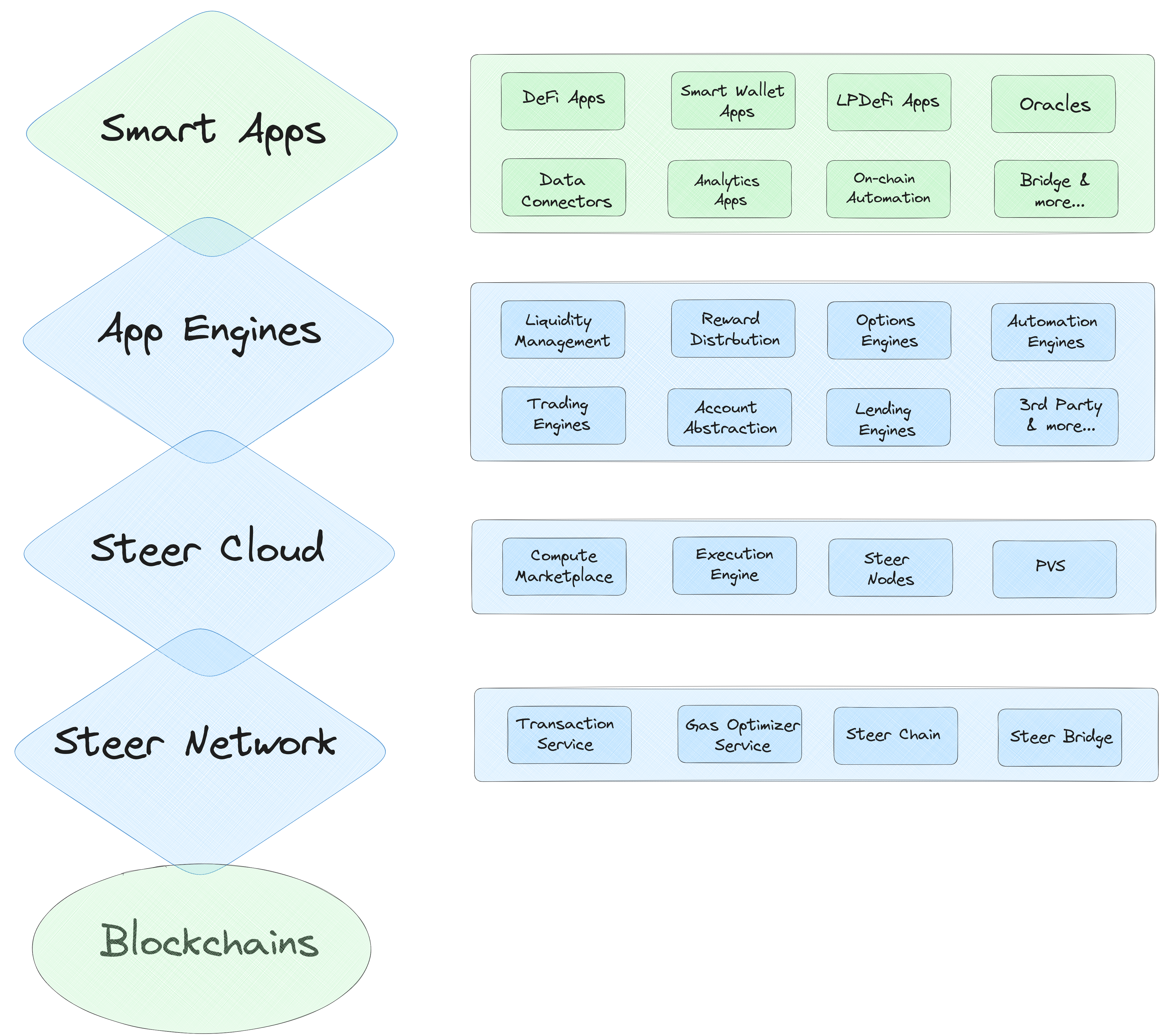Steer Architecture Overview

The Steer Modular architecture features a five-layer system that delivers efficiency, reliability, and precision. Built with a focus on security, this design ensures both safety and ease of use, making it a dependable choice for any application.
Here is an overview of its core components:
Steer Apps & Data Connectors -

An app is a set of instructions representing an intent based action on any web3 abstraction. An app consists of off-chain logic with access to data. These apps are then packaged into WASM bundles that are uploaded to the Steer Protocol. Apps can be written in any language that can be compiled into WASM, which are most of the popular ones such as Typescript (AssemblyScript), Python, Rust, etc; app can access any kind of data and hosted on any chain.
These apps can easily be build using wApp Kit (SDK, CLI & Plugins). Apps can support smart wallets as well, which can be installed into a EIP-6900 compatible Smart Wallet.
WASM provides immense security on the app level. Each WebAssembly module executes within a sandboxed environment separated from the host runtime using fault isolation techniques. This implies:
- Applications execute independently, and can’t escape the sandbox without going through appropriate APIs.
- Applications generally execute deterministically with limited exceptions.
- Checkout https://webassembly.org/docs/security/ to learn about security in webAssembly.
Data connectors, much like apps, are compiled into WebAssembly (WASM), which ensures similar levels of security. However, what sets data connectors apart is their ability to provide robust security measures at the data level, whether it is off-chain or on-chain data.
App Engines -

App engines are Web3 abstraction contracts that are built and audited by Steer with specific logic and parameters for a certain intent. These engines play a crucial role in ensuring the correct and secure execution of each steer app built on top of them, as well as providing convenient contracts to interact with your favorite protocols.
An app engine can have parameters that need to be configured before deployment on steer. These parameters help ensure the execution on chain occurs properly. For instance, an ALM yield generating app on uniswap v3 has parameters like twapInterval, max slippage, ratio error tolerance, and max tick change, which act as protectors during execution against sandwich attacks, high slippage, or any additional exploits unique to the app engine. These safeguards can catch situations where an action is no longer safe, and the system reverts and does not execute. These built-in security checks and anomaly detection mechanisms ensure that all executions are secured.
Steer Cloud -

The Steer Cloud is intent-focused compute infrastructure designed to deliver high-throughput, reliable and secure solutions for Steer Apps. When an app is built on an app engine, it is securely retrieved by every node in the Steer Cloud for execution or inside the protocol validated service. Each node--depending on the type of compute chosen--performs the various actions required for the app’s successful execution.
At the heart of each node lies the execution engine, responsible for extracting the app, loading it with the necessary data, and managing its execution. This engine is powered by two key services: the Observer and the Scheduler.
Observer Service: The Observer continuously monitors Steer contracts on-chain for new apps or emitted events. When a new app is detected, the Observer immediately stores its metadata in the node’s local database, ensuring that no app is overlooked.
Scheduler Service: The Scheduler manages the execution of apps stored in the local database. It schedules execution based on the app’s logic and constraints, using a priority queue system. This system considers factors such as app priority, dependencies, resource requirements, and execution time, ensuring efficient and orderly execution.
Both the Observer and Scheduler services operate around the clock as long as the node remains active on the Steer network, guaranteeing optimized and reliable app execution.
In addition to these core functions, each node offers supplementary services like app state monitoring, log recording, smart transaction management, coordination mechanisms, identity services, and database management. These additional services collectively ensure that every app runs smoothly and efficiently within the Steer Cloud.
Steer Network -

The Steer Network is a settlement layer on a specialized L3 chain, delivering ultra-efficient, high-throughput execution across 30+ blockchains, with seamless cross-chain bridging—all at a fraction of the cost.
After all nodes process the app and data through the execution and data pipeline they generate the final output, these results are sent to the Steer Network. Here, the outputs undergo on-chain voting and consensus verification to ensure the accuracy of the app intent execution. Once consensus is reached, the app intents are executed on the destination chain over the bridge and are recorded on blockchain, completing the process securely and efficiently.
Steer Network employs advanced services to enhance the efficiency and cost-effectiveness of app intent executions. The Transaction Manager is a critical component that guarantees the reliable execution of all app intents, ensuring seamless operations across the network. Additionally, the Gas Optimizer works to reduce expenses by optimizing the execution of intents, securing the lowest possible gas prices for users.
Key Services:
Transaction Manager: Ensures consistent and reliable execution of all app intents across the network.
Gas Optimizer: Minimizes costs by optimizing intent executions for the lowest gas fees.